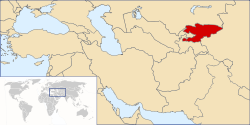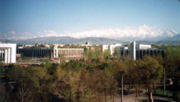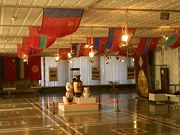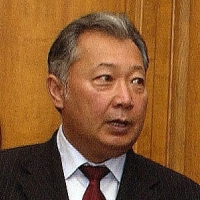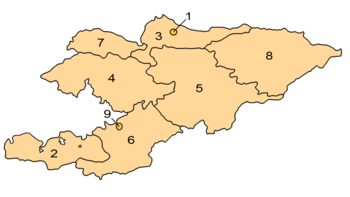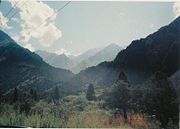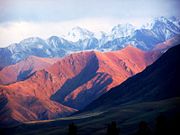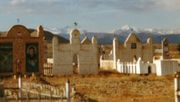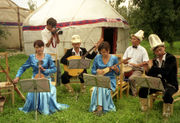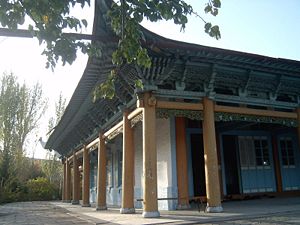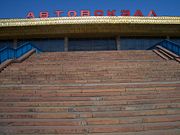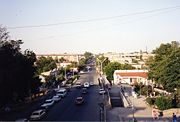Kyrgyzstan
2008/9 Schools Wikipedia Selection. Related subjects: Asia; Asian Countries
| Кыргыз Республикасы Kyrgyz Respublikasi Кыргызская Республика Kyrgyzskaya Respublika Kyrgyz Republic
|
||||||
|---|---|---|---|---|---|---|
|
||||||
| Motto: none | ||||||
| Anthem: National Anthem of the Kyrgyz Republic |
||||||
|
|
||||||
| Capital (and largest city) |
Bishkek |
|||||
| Official languages | Kyrgyz, Russian | |||||
| Demonym | Kyrgyz Kyrgyzstani |
|||||
| Government | Republic | |||||
| - | President | Kurmanbek Bakiyev | ||||
| - | Prime Minister | Igor Chudinov | ||||
| Independence | from the Soviet Union | |||||
| - | Declared | 31 August 1991 | ||||
| - | Completed | 25 December 1991 | ||||
| Area | ||||||
| - | Total | 199,900 km² ( 86th) 77,181 sq mi |
||||
| - | Water (%) | 3.6 | ||||
| Population | ||||||
| - | July 2005 estimate | 5,264,000 ( 111th) | ||||
| - | 1999 census | 4,896,100 | ||||
| - | Density | 26/km² ( 176th) 67/sq mi |
||||
| GDP ( PPP) | 2005 estimate | |||||
| - | Total | $10.764 billion ( 134th) | ||||
| - | Per capita | $2,150 ( 140th) | ||||
| Gini (2003) | 30.3 (medium) | |||||
| HDI (2007) | ▼ 0.696 (medium) ( 116th) | |||||
| Currency | Som ( KGS) |
|||||
| Time zone | KGT ( UTC+6) | |||||
| Internet TLD | .kg | |||||
| Calling code | +996 | |||||
Kyrgyzstan (pronounced /ˈkɻ̩gɪztɑn/ (AmE) or /'kɝgəztan/ (BrE), Kyrgyz: Кыргызстан [qɯrʀɯzˈstɑn]; Russian: Киргизия [kirˈgizija] or Киргизстан [ˈkirgistan] or Кыргызстан [ˈkˠɨrgˠɨz.stan], variously transliterated, also Kirgizia or Kirghizia), officially the Kyrgyz Republic, is a country in Central Asia. Landlocked and mountainous, it is bordered by Kazakhstan to the north, Uzbekistan to the west, Tajikistan to the southwest and China to the east.
History
Early history
According to recent historical findings, Kyrgyz history dates back to 201 BC. The early Kyrgyz lived in the upper Yenisey River valley, central Siberia. The discovery of the Pazyryk and Tashtyk cultures show them as a blend of Turkic nomadic tribes. Chinese and Muslim sources of the 7th–12th centuries AD describe the Kyrgyz as red-haired, in addition, blond-haired with a fair complexion and green or blue eyes.
The descent of the Kyrgyz from the indigenous Siberian population is confirmed on the other hand by recent genetic studies. Remarkably, 63% of the modern Kyrgyz men share Haplogroup R1a1 (Y-DNA) with Tajiks (64%), Ukrainians (54%), Poles (56%) and even Icelanders (25%). Haplogroup R1a1 (Y-DNA) is believed to be a marker of the Proto-Indo-European language speakers.
The Kyrgyz state reached its greatest expansion after defeating the Uyghur Khanate in 840 A.D. Then Kyrgyz quickly moved as far as the Tian Shan range and maintained their dominance over this territory for about 200 years. In the 12th century, however, the Kyrgyz domination had shrunk to the Altay Range and the Sayan Mountains as a result of the rising Mongol expansion. With the rise of the Mongol Empire in the 13th century, the Kyrgyz migrated south.
Russian influence
In the early 19th century, the southern part of what is today Kyrgyzstan came under the control of the Khanate of Kokand. The territory, then known in Russian as "Kirgizia", was formally incorporated into the Russian Empire in 1876. The Russian takeover was met with numerous revolts against tsarist authority, and many of the Kyrgyz opted to move to the Pamirs and Afghanistan. In addition, the suppression of the 1916 rebellion in Central Asia caused many Kyrgyz to migrate to China. Since many ethnic groups in the region were (and still are) split between neighbouring states, at a time when borders were more porous and less regulated, it was common to move back and forth over the mountains, depending on where life was perceived as better; this might mean better rains for pasture or better government after oppression.
Soviet era
Soviet power was initially established in the region in 1919 and the Kara-Kyrgyz Autonomous Oblast was created within the Russian SFSR (the term Kara-Kirghiz was used until the mid-1920s by the Russians to distinguish them from the Kazakhs, who were also referred to as Kirghiz). On December 5, 1936, the Kirghiz Soviet Socialist Republic was established as a full republic of the Soviet Union.
During the 1920s, Kyrgyzstan developed considerably in cultural, educational, and social life. Literacy was greatly improved, and a standard literary language was introduced by imposing Russian on the populace. Economic and social development also was notable. Many aspects of the Kyrgyz national culture were retained despite the suppression of nationalist activity under Stalin, and, therefore, tensions with the all-Union authorities were constant.
The early years of glasnost had little effect on the political climate in Kyrgyzstan. However, the Republic's press was permitted to adopt a more liberal stance and to establish a new publication, Literaturny Kirghizstan, by the Union of Writers. Unofficial political groups were forbidden, but several groups that emerged in 1989 to deal with the acute housing crisis were permitted to function.
In June 1990, ethnic tensions between Uzbeks and Kyrgyz surfaced in the Osh Oblast, where Uzbeks form a majority of the population. Violent confrontations ensued, and a state of emergency and curfew were introduced. Order was not restored until August 1990.
The early 1990s brought considerable change to Kyrgyzstan. By then, the Kyrgyzstan Democratic Movement (KDM) had developed into a significant political force with support in Parliament. In an upset victory, Askar Akayev, the liberal President of the Kyrgyz Academy of Sciences, was elected to the Presidency in October 1990. The following January, Akayev introduced new government structures and appointed a new government composed mainly of younger, reform-oriented politicians.
In December 1990, the Supreme Soviet voted to change the republic's name to the Republic of Kyrgyzstan. (In 1993, it became the Kyrgyz Republic.) In February 1991, the name of the capital, Frunze, was changed back to its prerevolutionary name of Bishkek. Despite these aesthetic moves toward independence, economic realities seemed to work against secession from the Soviet Union. In a referendum on the preservation of the Soviet Union in March 1991, 88.7% of the voters approved the proposal to retain the Soviet Union as a "renewed federation."
On August 19, 1991, when the State Emergency Committee assumed power in Moscow, there was an attempt to depose Akayev in Kyrgyzstan. After the coup collapsed the following week, Akayev and Vice President German Kuznetsov announced their resignations from the Communist Party of the Soviet Union (CPSU), and the entire bureau and secretariat resigned. This was followed by the Supreme Soviet vote declaring independence from the Soviet Union on August 31, 1991.
Independence
In October 1991, Akayev ran unopposed and was elected president of the new independent Republic by direct ballot, receiving 95% of the votes cast. Together with the representatives of seven other Republics that same month, he signed the Treaty of the New Economic Community. Finally, on December 21, 1991, Kyrgyzstan joined with the other four Central Asian Republics to formally enter the new Commonwealth of Independent States. In 1992, Kyrgyzstan joined the UN and the CSCE.
The " Tulip Revolution," after the parliamentary elections in March 2005, forced President Akayev's resignation on April 4, 2005. Opposition leaders formed a coalition and a new government was formed under President Kurmanbek Bakiyev and Prime Minister Feliks Kulov. The nation's capital was also looted during the protests.
Political stability appears to be elusive, however, as various groups and factions allegedly linked to organized crime are jockeying for power. Three of the 75 members of Parliament elected in March 2005 were assassinated, and another member was assassinated on 10 May 2006 shortly after winning his murdered brother's seat in a by-election. All four are reputed to have been directly involved in major illegal business ventures.
Current concerns in Kyrgyzstan include: privatization of state-owned enterprises, expansion of democracy and political freedoms, inter-ethnic relations, and terrorism.
Politics
The 1993 constitution defines the form of government as a democratic republic. The executive branch includes a president and prime minister. The parliament currently is unicameral. The judicial branch comprises a Supreme Court, a Constitutional Court, local courts, and a Chief Prosecutor.
In March 2002, in the southern district of Aksy, five people protesting the arbitrary arrest of an opposition politician were shot dead by police, sparking nationwide protests. President Akayev initiated a constitutional reform process which initially included the participation of a broad range of government, civil, and social representatives in an open dialogue, leading to a February 2003 referendum marred by voting irregularities. The amendments to the constitution approved by the referendum resulted in stronger control by the president and weakened the parliament and the Constitutional Court. Parliamentary elections for a new, 75-seat unicameral legislature were held on February 27 and March 13, 2005, but were widely viewed as corrupt. The subsequent protests led to a bloodless coup on March 24, after which Akayev fled the country and was replaced by acting president Kurmanbek Bakiyev. (see: Tulip Revolution).
Interim government leaders are developing a new governing structure for the country and working to resolve outstanding constitutional issues. On July 10, 2005, acting president Bakiyev won the presidential election in a landslide, with 88.9% of the vote, and was inaugurated on 14 August. However, initial public support for the new administration substantially declined in subsequent months as a result of its apparent inability to solve the corruption problems that have plagued the country since its independence from the Soviet Union, along with the murders of several members of parliament. Largescale protests against president Bakiyev took place in Bishkek in April and November of 2006, with opposition leaders accusing the president of failing to live up to his election promises to reform the country's constitution and transfer many of his presidential powers to parliament.
Provinces and districts
Kyrgyzstan is divided into seven provinces (sing. oblast (область), pl. oblasttar (областтар)) administered by appointed governors. The capital, Bishkek, and the second large city Osh are administratively the independent cities (shaar) with a status equal to a province.
The provinces, and independent cities, are as follows:
- Bishkek (city)
- Batken
- Chui
- Jalal-Abad
- Naryn
- Osh (province)
- Talas
- Issyk-Kul
- Osh (city)
Each province comprises a number of districts ( raions), administered by government-appointed officials (akim). Rural communities (ayıl ökmötü), consisting of up to twenty small settlements, have their own elected mayors and councils.
Geography
Kyrgyzstan is a landlocked country in Central Asia, bordering Kazakhstan, China, Tajikistan and Uzbekistan. The mountainous region of the Tian Shan covers over 80% of the country (Kyrgyzstan is occasionally referred to as "the Switzerland of Central Asia", as a result ), with the remainder made up of valleys and basins. Lake Issyk-Kul in the north-western Tian Shan is the largest lake in Kyrgyzstan and the second largest mountain lake in the world after Titicaca. The highest peaks are in the Kakshaal-Too range, forming the Chinese border. Peak Jengish Chokusu, at 24,400 feet (7,439 m), is the highest point and is considered by geologists (though not mountaineers) to be the northernmost 23,000 foot (7,000 m) peak in the world. Heavy snowfall in winter leads to spring floods which often cause serious damage downstream. The runoff from the mountains is also used for hydro-electricity.
The climate varies regionally. The south-western Fergana Valley is subtropical and extremely hot in summer, with temperatures reaching 40°C (104°F.) The northern foothills are temperate and the Tian Shan varies from dry continental to polar climate, depending on elevation. In the coldest areas temperatures are sub-zero for around 40 days in winter, and even some desert areas experience constant snowfall in this period.
Kyrgyzstan has significant deposits of metals including gold and rare earth metals. Due to the country's predominantly mountainous terrain, less than 8% of the land is cultivated, and this is concentrated in the northern lowlands and the fringes of the Fergana Valley.
Bishkek in the north is the capital and largest city, with approximately 900,000 inhabitants (as of 2005). The second city is the ancient town of Osh, located in the Fergana Valley near the border with Uzbekistan. The principal river is the Naryn, flowing west through the Fergana Valley into Uzbekistan, where it meets another of Kyrgyzstan's major rivers, the Kara Darya, forming the Syr Darya which eventually flows into the Aral Sea — although the massive extraction of water for irrigating Uzbekistan's cotton fields now causes the river to dry up long before reaching the Sea. The Chu River also briefly flows through Kyrgyzstan before entering Kazakhstan.
Enclaves and exclaves
There is one exclave, the tiny village of Barak, Kyrgyzstan, (population 627) in the Fergana valley. The village is surrounded by Uzbek territory and located between the towns of Margilan and Fergana.
There are four Uzbek enclaves within Kyrgyzstan. Two of them are the towns of Sokh (area 125 sq. mi/325 km² and a population of 42,800 in 1993, although some estimates go as high as 70,000; 99% are Tajiks, the remainder Uzbeks), and Shakhrimardan (also known as Shakirmardon or Shah-i-Mardan, area 35 sq. mi/90 km² and a population of 5,100 in 1993; 91% are Uzbeks, the remainder Kyrgyz); the other two are the tiny territories of Chuy-Kara (or Kalacha, roughly 3 km long by 1 km wide or 2 mi by 0.6 mi) and Dzhangail (a dot of land barely 2 or 3 km across). Chuy-Kara is on the Sokh river, between the Uzbek border and the Sokh enclave.
There also are two enclaves belonging to Tajikistan: Vorukh (exclave area between 95 and 130 km² [37–50 sq. mi], population estimated between 23,000 and 29,000, 95% Tajiks and 5% Kyrgyz, distributed among 17 villages), located 45 kilometres (28 mi) south of Isfara on the right bank of the Karafshin river, and a small settlement near the Kyrgyz railway station of Kairagach.
Economy
Despite the backing of major Western lenders, including the International Monetary Fund (IMF), the World Bank and the Asian Development Bank, Kyrgyzstan has had economic difficulties following independence. Initially, these were a result of the breakup of the Soviet trading bloc and resulting loss of markets, which impeded the republic's transition to a free market economy. The government has reduced expenditures, ended most price subsidies, and introduced a value-added tax. Overall, the government appears committed to the transition to a market economy. Through economic stabilization and reform, the government seeks to establish a pattern of long-term consistent growth. Reforms led to Kyrgyzstan's accession to the World Trade Organization (WTO) on December 20, 1998.
The Kyrgyz economy was severely affected by the collapse of the Soviet Union and the resulting loss of its vast market. In 1990, some 98% of Kyrgyz exports went to other parts of the Soviet Union. Thus, the nation's economic performance in the early 1990s was worse than any other former Soviet republic except war-torn Armenia, Azerbaijan, and Tajikistan, as factories and state farms collapsed with the disappearance of their traditional markets in the former Soviet Union. While economic performance has improved considerably in the last few years, and particularly since 1998, difficulties remain in securing adequate fiscal revenues and providing an adequate social safety net.
Agriculture is an important sector of the economy in Kyrgyzstan (see agriculture in Kyrgyzstan). By the early 1990s, the private agricultural sector provided between one-third and one-half of some harvests. In 2002 agriculture accounted for 35.6% of GDP and about half of employment. Kyrgyzstan's terrain is mountainous, which accommodates livestock raising, the largest agricultural activity, so the resulting wool, meat, and dairy products are major commodities. Main crops include wheat, sugar beets, potatoes, cotton, tobacco, vegetables, and fruit. As the prices of imported agrichemicals and petroleum are so high, much farming is being done by hand and by horse, as it was generations ago. Agricultural processing is a key component of the industrial economy, as well as one of the most attractive sectors for foreign investment.
Kyrgyzstan is rich in mineral resources but has negligible petroleum and natural gas reserves; it imports petroleum and gas. Among its mineral reserves are substantial deposits of coal, gold, uranium, antimony, and other valuable metals. Metallurgy is an important industry, and the government hopes to attract foreign investment in this field. The government has actively encouraged foreign involvement in extracting and processing gold. The country's plentiful water resources and mountainous terrain enable it to produce and export large quantities of hydroelectric energy.
On a local level, the economy is primarily kiosk in nature. A large amount of local commerce occurs at bazaars and small village kiosks. Commodities such as gas (petrol) are often sold road-side in gallon jugs. A significant amount of trade is unregulated. There is also a scarcity of common everyday consumer items in remote villages. Thus a large number of homes are quite self-sufficient with respect to food production. There is a distinct differentiation between urban and rural economies.
The principal exports are nonferrous metals and minerals, woolen goods and other agricultural products, electric energy, and certain engineering goods. Imports include petroleum and natural gas, ferrous metals, chemicals, most machinery, wood and paper products, some foods, and some construction materials. Its leading trade partners include Germany, Russia, and neighboring China, Kazakhstan and Uzbekistan.
Demographics
The World Almanac 2005 reported that Kyrgyzstan's population is slightly more than five million, estimating it at 5,081,429. Of those, 34.4% are under the age of 15 and 6.2% are over the age of 65. The country is rural; only about one-third (33.9%) of Kyrgyzstan's population live in urban areas. The average population density is 69 people per square mile (29 people per km²).
The nation's largest ethnic group is the Kyrgyz, a Turkic people. The Kyrgyz comprise 69.5% of the population and have historically been semi- nomadic herders, living in round tents called yurts and tending sheep, horses and yaks. This nomadic tradition continues to function seasonally (see transhumance) as herding families return to the high mountain pasture (or jailoo) in the summer. The retention of this nomadic heritage and the freedoms that it assumes continue to have an impact on the political atmosphere in the country. The name Kyrgyz, both for the people and for the nation itself, is said to mean "forty girls", a reference to the Manas of folklore unifying forty tribes against the Mongols.
Other ethnic groups include ethnic Russians (9.0%) concentrated in the North and Uzbeks (14.5%) living in the South. Small but noticeable minorities include Tatars (1.9), Uyghurs (1.1%), Tajiks (1.1%), Kazakhs (0.7%) and Ukrainians (0.5%), and other smaller ethnic minorities (1.7%). Of the formerly sizable Volga German community, exiled here by Stalin from their earlier homes in the Volga German Republic, most have returned to Germany, and only a few small groups remain. A small percentage of the population are also Soviet Koreans, meaning descendents of the former Korean residents of Vladivostok, whom Stalin had exiled to Central Asia (and the Caucasus) during the Second World War.
Languages
Kyrgyzstan is one of two of the five former Soviet republics in Central Asia to retain Russian as an official language (Kazakhstan is the other country to retain Russian). It added the Kyrgyz language to become an officially bilingual country in September 1991. This sent a clear signal to the ethnic Russians that they were welcome in the new independent state, in an effort to avoid a brain drain. Kyrgyz is a member of the Turkic group of languages and was written in the Arabic alphabet until the 20th century. Latin script was introduced and adopted in 1928, and was subsequently replaced by Cyrillic script in 1941.
Generally, people all over the country understand and speak Russian, except for some remote mountain areas. Russian is the mother tongue of the majority of Bishkek dwellers, and most business and political affairs are carried out in this language. Until recently, Kyrgyz remained a language spoken at home, and was rarely used during meetings or other events. However, most parliamentary meetings today are conducted in Kyrgyz, with simultaneous interpretation available for those not speaking Kyrgyz.
Culture
- Manas, an epic poem
- Komuz, a three-stringed lute
- Tush kyiz, large, elaborately embroidered wall hangings
- Shirdak, flat cushions made in shadow-pairs
- other textiles, especially made from felt
- Falconry
Traditions
Illegal, but still practiced, is the tradition of bride kidnapping.
It is debatable whether bride kidnapping is actually traditional. Some of the confusion may stem from the fact that arranged marriages were traditional, and one of the ways to escape an arranged marriage was to arrange a consensual "kidnapping."
Religion
During Soviet times, state atheism was encouraged. Today, however, Kyrgyzstan is a secular state though Islam has exerted growing influence in politics.. For instance, there have been various attempts to decriminalize polygamy, and to arrange for officials to travel on hajj (the pilgrimage to Mecca) under a tax-free arrangement. Kyrgyzstan is an overwhelmingly Sunni Muslim nation, and adheres to the Hanafi school of thought.
While Islam in Kyrgyzstan is more of a cultural background than a devout daily practice for many, public figures have expressed support for restoring religious values. For example, human rights ombudsman Tursunbay Bakir-Ulu noted, "In this era of independence, it is not surprising that there has been a return to spiritual roots not only in Kyrgyzstan, but also in other post-communist republics. It would be immoral to develop a market-based society without an ethical dimension." Additionally, Bermet Akayeva, the daughter of Askar Akayev, the former President of Kyrgyzstan, stated during a July 2007 interview that Islam is increasingly taking root across the nation. She emphasized that many mosques have been built and that the Kyrgyz are increasingly devoting themselves to Islam, which she noted was "not a bad thing in itself. It keeps our society more moral, cleaner."
The other faiths practiced in Kyrgyzstan include Russian Orthodox and Ukrainian Orthodox versions of Christianity, practiced primarily by Russians and Ukrainians respectively. A small minority of Germans are Protestant Christians, mostly Lutherans and Baptists. A few Animistic traditions survive, as do influences from Buddhism such as the tying of prayer flags onto sacred trees, though some view this practice rooted within Sufi Islam. There are also a small number of Bukharian Jews living in Kyrgyzstan, but during the collapse of the Soviet Union most fled to other countries, mainly the United States and Israel.
Flag
The 40-rayed yellow sun in the centre of the flag represents 40 warriors of the mythical hero Manas. The lines inside the sun represent the crown or tündük (Kyrgyz түндүк) of a yurt, a symbol replicated in many facets of Kyrgyz architecture. The red portion of the flag represents peace and openness of Kyrgyzstan.
Education
Educational institutions in Kyrgyzstan include:
- University of Central Asia
- American University of Central Asia
- Bishkek Humanities University
- International Ataturk-Alatoo University
- International University of Kyrgyzstan
- Kyrgyz National University
- Arabaev Kyrgyz State University
- Kyrgyz Russian Slavonic University
- Kyrgyz-Russian State University
- Kyrgyz-Turkish MANAS University
- Kyrgyz Uzbek University
- Moskov Institute of Law and Enterprise
- Osh State University
- Osh Technological University
Horse riding
The traditional national sports reflect the importance of horse riding in Kyrgyz culture.
Very popular, as in all of Central Asia, is Ulak Tartysh, a team game resembling a cross between polo and rugby in which two teams of riders wrestle for possession of the headless carcass of a goat, which they attempt to deliver across the opposition's goal line, or into the opposition's goal: a big tub or a circle marked on the ground.
Other popular games on horseback include:
- Aht Chabysh - a long-distance horse race, sometimes over a distance of more than 50 km
- Jumby Atmai - a large bar of precious metal (the "jumby") is tied to a pole by a thread and contestants attempt to break the thread by shooting at it, while at a gallop
- Kyz Kuumai - a man chases a girl in order to win a kiss from her, while she gallops away; if he is not successful she may beat him with her "kamchi" (horsewhip)
- Oodarysh - two contestants wrestle on horseback, each attempting to be the first to throw the other from his horse
- Tyin Enmei - picking up a coin from the ground at full gallop
Transport
Transport in Kyrgyzstan is severely constrained by the country's alpine topography. Roads have to snake up steep valleys, cross passes of 3,000 metre (9,000 ft) altitude and more, and are subject to frequent mud slides and snow avalanches. Winter travel is close to impossible in many of the more remote and high-altitude regions. Additional problems are due to the fact that many roads and railway lines built during the Soviet period are today intersected by international boundaries, requiring time-consuming border formalities to cross where they are not completely closed. Horses are still a much-used transport option, especially in more rural areas; Kyrgyzstan's road infrastructure is not extensive, so horses are able to reach locations that motor vehicles cannot, and they do not require expensive, imported fuel.
Airports
At the end of the Soviet period there were about 50 airports and airstrips in Kyrgyzstan, many of them built primarily to serve military purposes in this border region so close to China. Only a few of them remain in service today.
- Manas Airport near Bishkek is the main international airport, with services to Moscow, Tashkent, Urumqi, Istanbul, Baku, Delhi and London.
- Osh Airport is the main air terminal in the South, with daily connections to Bishkek.
- Jalal-Abad Airport is linked to Bishkek by two flights per week.
- Other facilities built during the Soviet era are either closed down, used only occasionally or restricted to military use (e.g., Kant airbase, now a Russian air base near Bishkek)
Railways
The Chui valley in the north and the Ferghana valley in the south were endpoints of the Soviet Union's rail system in Central Asia. Following the emergence of independent post-Soviet states, the rail lines which were built without regard for administrative boundaries have been cut by borders, and traffic is therefore severely curtailed. The small bits of rail lines within Kyrgyzstan, about 370 km (1,520 mm broad gauge) in total, have little economic value in the absence of the former bulk traffic over long distances to and from such centers as Tashkent, Almaty and the cities of Russia.
There are vague plans about extending rail lines from Balykchy in the north and/or from Osh in the south into the People's Republic of China, but the cost of construction would be enormous.
Rail links with adjacent countries
- Kazakhstan - yes - Bishkek branch - same gauge
- Uzbekistan - yes - Osh branch - same gauge
- Tajikistan - no - same gauge
- China - no - Break of gauge 1524mm/1435mm
Highways
With support from the Asian Development Bank, a major road linking the north and southwest from Bishkek to Osh has recently been completed. This considerably eases communication between the two major population centers of the country -- the Chui Valley in the north and the Fergana Valley in the South. An offshoot of this road branches off across a 3,500 meter pass into the Talas Valley in the northwest. Plans are now being formulated to build a major road from Osh into the People's Republic of China.
total: 30,300 km (including 140 km of expressways)
paved: 22,600 km (includes some all-weather gravel-surfaced roads)
unpaved: 7,700 km (these roads are made of unstabilized earth and are difficult to negotiate in wet weather) (1990)
Pipelines
Natural gas 200 km
Waterways
Water transport exists only on Lake Issyk Kul, and has drastically shrunk since the end of the Soviet Union.
Ports and harbours
Balykchy (Ysyk-Kol or Rybach'ye), on Lake Issyk Kul.


